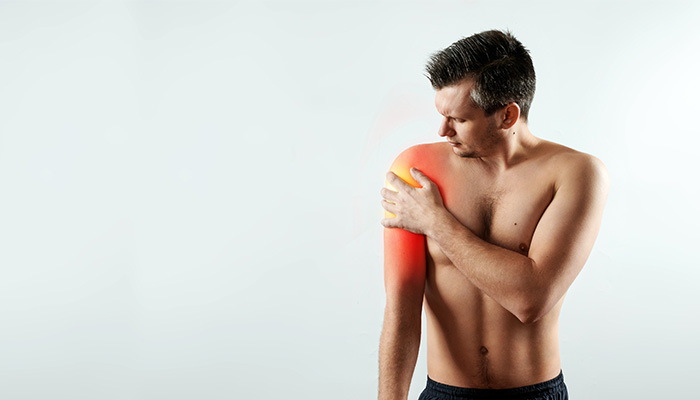Flexibility is what gives us the ability to do any work. If right now we are able to type on the keyboard, move the mouse, twist and turn our heads, fold our elbows and knees, it is because our body is not a single piece of skeleton. There are many smaller and larger bones that join together to form the whole skeleton. The junction at which the one bone meets another is called as joint. Joint offers flexibility that allows it to withstand the highest possible pressure. One very important joint in the upper part of the body is the shoulder joint.
About Adhesive Capsulitis
The shoulder joint is crucial and plays a very important role in carrying out daily activities. The importance of the shoulder joint is not noticed until there is a problem. The shoulder joint can be easily moved in all directions without pain and discomfort. However, some people find it hard to move their shoulders. They feel pain when trying to move or lift the shoulder. This condition is known as adhesive capsulitis or frozen shoulder as the shoulder joint gets stiff and moving the shoulder becomes difficult. As the shoulder joint is very important, it is essential to determine the precise cause of the loss of mobility prior to treatment.
Causes
The medical term “adhesive capsulitis” describes the exact meaning of the condition, where adhesive means “sticky” and capsulitis means “damage or inflammation of the joint capsule”. Adhesive capsulitis develops when the connective tissue in the shoulder joint tightens and makes it difficult to move the shoulder. The tightening of the shoulder joint usually occurs when the shoulder joint was immobilized for several weeks due to injury, surgery, rotor cuff injury, and wearing a sling for several weeks. The causes of adhesive capsulitis can be classified as
- Primary reasons, where the cause is unknown
- Secondary reasons, caused as a result of surgery, illness or trauma
Physicians are uncertain as to why joint stiffness occurs in some individuals and does not occur in others. Adhesive capsulitis is known to be associated with individuals having diabetes, thus it is believed to be caused by an autoimmune process in which the body’s immune system reacts against its own organs. Individuals who are aged 40 and over, have diabetes, have osteoarthritis or have disease of the cervical disc are at an increased risk of developing this condition. Females are also more likely to develop adhesive capsulitis than males. Additionally, long-term immobile shoulder can be caused by a variety of causes, such as injury to the shoulder, surgery, fracture of the arm, or stroke. Other risk factors include open heart surgery and hyperthyroidism.
Symptoms
The symptoms of adhesive capsulitis differ according to the stage or phase it is in. The condition is classified into three stages
- Freezing stage: This stage lasts for almost 2-9 months. This is the painful stage when the person experience symptoms like gradual pain during movement of the shoulder, pain increases when lying on bed on the affected side, and the movement of the shoulder gradually decreases.
- Frozen stage: This phase is called as the stiffened phase, which lasts for 4-12 months. The pain remains and stiffening of the shoulder gradually increases, everyday’s activities become difficult, and muscle wasting (decrease in size of skeletal muscles) can be noticed due to lack of use of the shoulder joint.
- Thawing stage: This stage lasts for 5-12 months and is called as the recovery stage, the pain and stiffness gradually subsides, there is sufficient improvement in the shoulder movement.
Diagnosis
The diagnosis of adhesive capsulitis is based on the patient’s symptoms and physical examination. The physician may apply mild pressure to the shoulder area to determine where the pain is most intense and its underlying cause. X-ray or magnetic resonance imaging (MRI) scanning of the shoulder area showing the inflammation will help determine the exact cause of the problem.
Treatment
The treatment for adhesive capsulitis is aimed at the symptoms experienced by the patient. A non-steroid anti-inflammatory drug and steroid injections are prescribed for pain. Steroid injections along with physical exercise may help faster recovery. The physician or the physiotherapist will teach the patient exercises that will help to release the stiffened shoulder joint. Medications will be prescribed for risk factors like diabetes, thyroid problems etc. Injecting sterile water directly into the shoulder joint will help stretch the tissues in the region and allow easy movement. Finally, if non-surgical treatment option do not show any result the doctor may plan for shoulder arthroscopy surgery. This surgery is performed under local anesthesia, where the scar tissue is released, allowing the shoulder to return to normal range of motion. Some doctors will prescribe painkillers after surgery so the patient can attend physical therapy.
Exercises for adhesive capsulitis
Effective exercises for adhesive capsulitis are
- Climbing the wall like a spider, the person can pause for 30 seconds as they ascend. The goal is to climb up as high as possible.
- Codman exercise is very simple, for this, the person needs to sit sideways in the chair and rest his affected arm at the back of the chair, and swing it around slowly. Initially make smaller circles and then start making bigger circles. Remember to swing the hand in both directions.
- Stretching both arms backward and clasping them together behind the back helps to relax the stiffened tissue. Hold the arm in position for 10 seconds and repeat it for another 5 times.
- Reaching exercise includes daily activities like reaching for shoes, brush, or coffee mugs that are placed high.
While exercising the affected shoulder, it is also essential to perform exercises with a normal healthy shoulder to ensure that movement of that shoulder is maintained.
Outlook
The phrase “If you don’t use it, you lose it” applies best for shoulder disease because any voluntary or involuntary immobilization of the shoulder may result in loss of mobility. It is advised that patients with immobile shoulders not use steroids immediately. Steroids may have adverse effects on blood glucose levels. Learning the fundamental exercise and doing it at home will help the patient recover more quickly.



